When Abstract art was launched in the early part of the 20th century it revolutionized the art world. Many of the leading artists of the time chose this style as a rebellious departure from figurative art. They used the visual language of shape, form, color and line to create compositions with few or no references to the natural world. Rejecting the constraints of Realism, Abstract artists sought to explore the worlds of their imagination, freedom of expression, and follow their desire to unleash spontaneity through their chosen medium. Over the years many artists, theorists, historians and critics have expressed many different views of Abstract art.
In this article you’ll find art by a few members of Manhattan Arts International who use Abstract art elements. You’ll find their diverse statements and links to their pages so you can view more of their artwork.
Please note, since this article was published in March, 2019, we have added more abstract artists to our online art gallery.
Different Beliefs, Opinions & Sources of Inspiration About Abstract Art
One could say that almost all art is Abstract art, if we consider that Abstraction is a process of drawing inspiration from the shape, color and texture of objects. After all, artists have “abstracted” from the world around them since prehistoric times. Artists, art critics and historians have entered many different sides of discussion, debate and contradictory opinions about Abstract art over decades. Here are a few…
“There is no abstract art. You must always start with something. Afterward you can remove all traces of reality.” ~ Pablo Picasso
“What goes on in abstract art is the proclaiming of aesthetic principles… It is in our own time that we have become aware of pure aesthetic considerations. Art never can be imitation.”
~ Hans Hofmann
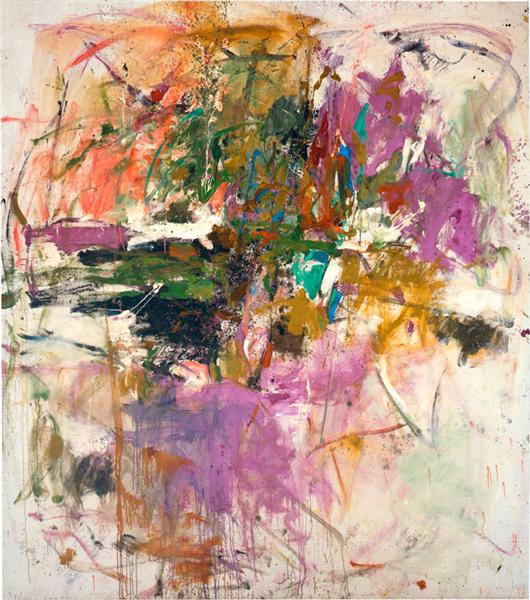 Untitled, abstract expressionist painting by Joan Mitchell, 1961. Photo: Fair Use. wikiart.org
Untitled, abstract expressionist painting by Joan Mitchell, 1961. Photo: Fair Use. wikiart.org
“Abstract is not a style. I simply want to make a surface work. This is just a use of space and form: it’s an ambivalence of forms and space. ~ Joan Mitchell
“We are all hungry and thirsty for concrete images. Abstract art will have been good for one thing: to restore its exact virginity to figurative art.”
~ Salvador Dali
“Just as pure abstract art is not dogmatic, neither is it decorative.”
~ Piet Mondrian
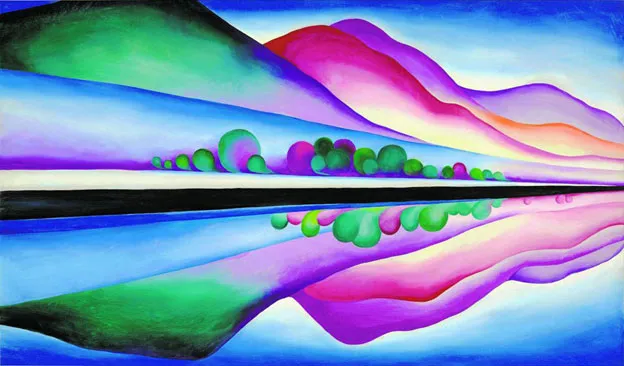 Lake George, painting by Georgia O’Keeffe. Public domain.
Lake George, painting by Georgia O’Keeffe. Public domain.
“Objective painting is not good painting unless it is good in the abstract sense. A hill or tree cannot make a good painting just because it is a hill or tree. It is lines and colors put together so that they may say something.” ~ Georgia O’Keeffe
“The less there is to look at, the more important it is that we look at it closely and carefully. This is critical to abstract art. Small differences make all the difference.”
~ Kirk Varnedoe, Pictures of Nothing: Abstract Art Since Pollock
“I’m not an Abstractionist. I’m not interested in the relationship of color or form or anything else. I’m interested only in expressing basic human emotions: tragedy, ecstasy, doom, and so on.” ~ Mark Rothko
“I’m not an abstract artist; I leave that to others. To me, abstract art ended with Kazimir Malevich’s ‘Black Square.’ To continue it is senseless.” ~ Jonas Mekas
“Everybody knows that abstract art can be art, and most people know that they may not like it, even if they understand there’s another purpose to it.” ~ Roy Lichtenstein
Ways to View Abstract Art

Wassily Kandinsky, Blue Mountain, oil on canvas, 194.3 x 129.3 cm. Created in 1908 in Munich / Monaco, Germany. Current location: Solomon R. Guggenheim Museum, New York City, NY, US. Photo: Public domain. wikiart.org
When contemplating a purchase of abstract artwork open yourself up to your inner world of imagination and the unlimited possibilities of the experience. Rather than focusing on the formal elements of the work of art before you, allow yourself to succumb to the sensations that they produce in you. How does the art make you feel?
“Form itself, even if completely abstract … has its own inner sound.” ~ Wassily Kandinsky
You might think of Abstract art as Wassily Kandinsky did, a kind of musical composition, in which the artist uses line, color, volume, composition, balance, rhythm and subjective aspects such as the feelings and ideas they have and want to convey to you. Kandinsky encouraged us, “Form itself, even if completely abstract … has its own inner sound.”
The artist who creates Abstract art may often enter the realm of transcendental, contemplative, visionary and timeless themes. And, they take us along on their journey with an invitation to discover our own interpretations.
A Few Manhattan Arts International Artist Members Who Create Abstract Art
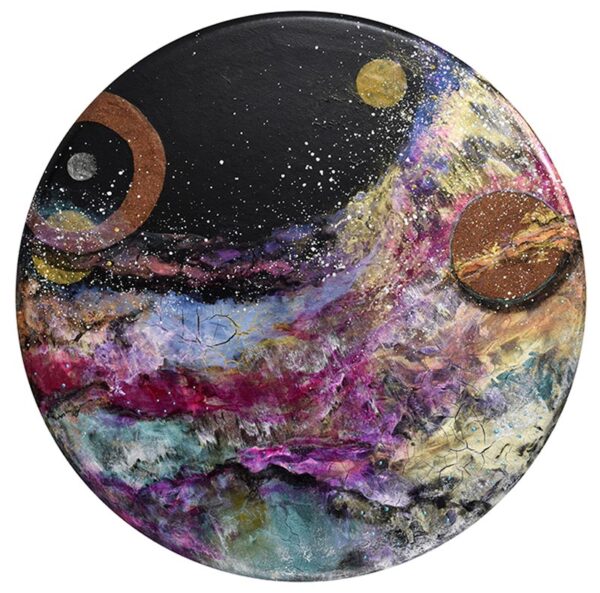
Sandra Duran Wilson, The Place Between, mixed media, 24 inch diameter. Visit her page.
Breaking the Rules
Sandra Duran Wilson is a multi-talented artist and author of art technique books. Her knowledge about styles and artistic methods are extensive. She states, “My art lives on the border between abstraction and the natural world. I paint my vision of galactic spaces, other worlds, serene abstract landscapes and abstract adventures. I have learned the rules so that I may break them and put them back together in a new way.”
She continues, “My art is driven by curiosity and the possibilities of what materials can do, especially when combined in unusual ways. I incorporate printmaking, collage, acrylic painting, and even three-dimensional elements into my work. I explore concepts like time travel and physics along with dreams and symbols. A kind of crazy mixed-up world of science and fantasy.”
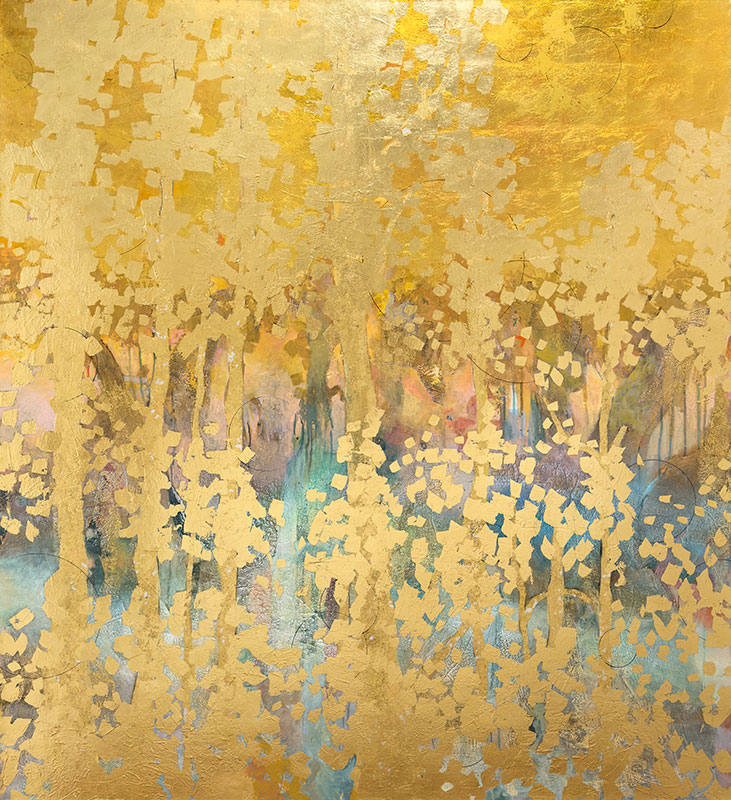 Nancy Reyner, Brilliance, acrylic and gold leaf on canvas, 66″ x 60″. Visit her page.
Nancy Reyner, Brilliance, acrylic and gold leaf on canvas, 66″ x 60″. Visit her page.
Merging Abstraction with Nature
Nancy Reyner creates ethereal paintings of exceptional depth and beauty. “Nature is my guiding principle to portray luminous notions of air, water, earth and light. Creating imaginary new worlds, merging the literal and the metaphorical, my paintings hover somewhere between pure abstraction and realistic landscape.”
Reyner has written extensively about the creative process and techniques and is the author of several books. She states, “The ability to dream and to create new worlds by taking a flat surface and transforming it, is the gift that painters can bring to the world. With this concept of manipulating dimensions, a painter may point out something that already exists but in such a skillful manner that the viewer sees it in a brand new way.” She adds, “Thus painting can alter the viewer’s perception by launching them into an exploration of their own thoughts and beliefs.”
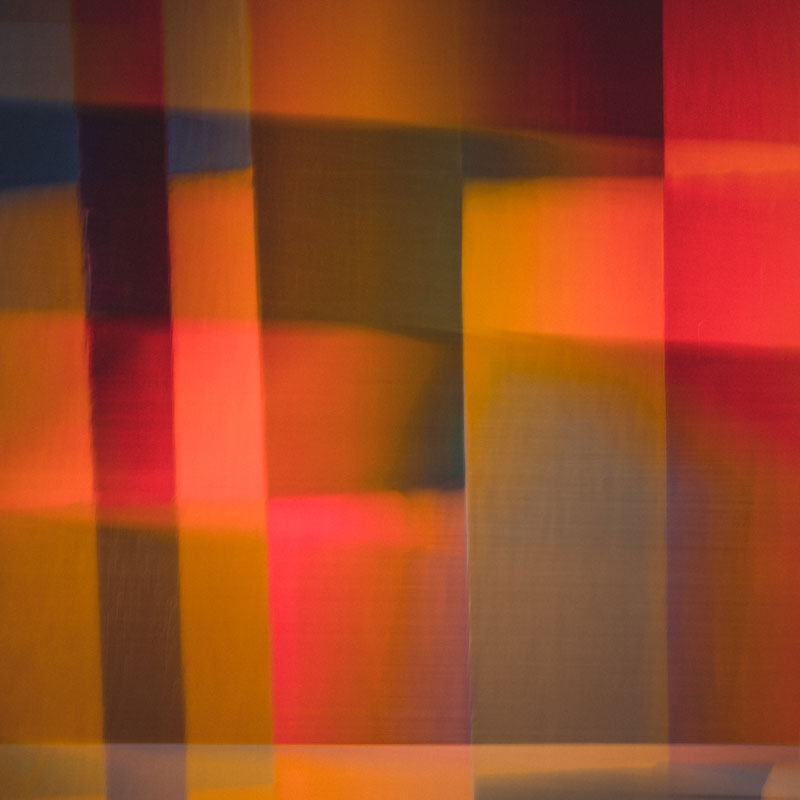 Michael Amrose, Abstract 6.1 Untitled #70, digital photography, 25″ x 25″. Visit his page.
Michael Amrose, Abstract 6.1 Untitled #70, digital photography, 25″ x 25″. Visit his page.
Transcending the Limits of Thought
“Abstract art is powerful because it reaches into the viewer’s inner psyche by minimizing conscious distractions while evoking unconscious feelings. As a result, abstract photography presents me with unlimited possibilities to explore and communicate the many dimensions of human emotions, and in turn, give rise to emotive responses from the viewer. Consequently, I can express myself through a unique, visual language where the vocabulary has deep cultural and emotional connections.”
Michael’s purpose is clear. He states, “I strive to expand the boundaries of the photographic medium beyond traditional approaches and the medium’s ability to reproduce reality. Process plays an integral part in photographic art. My subject is created considering the symbolic psychological and cultural impact on the viewer of specific colors, shapes, and form.”
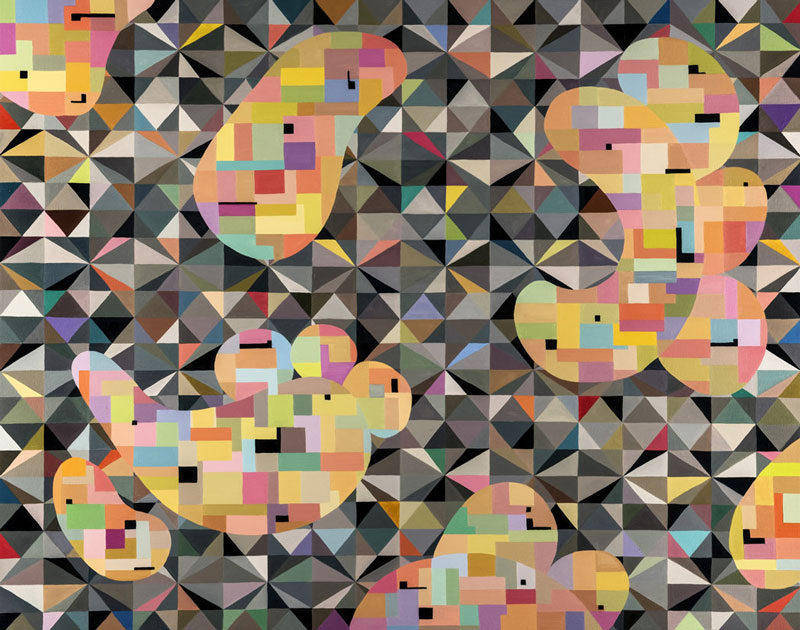 Kari Bienert, From the Beginning, oil on canvas, 70.8″ x 17.3″. Visit her page.
Kari Bienert, From the Beginning, oil on canvas, 70.8″ x 17.3″. Visit her page.
Using An Endless Variety of Rhythms and Patterns
Kari Bienert is a Color Field painter, inspired by Op Art and Lyrical Abstract elements and Geometric Abstraction. She states, “Painting is my dreamtime and has been my passion for over 20 years. Colours come together to form language and shape from my intense engagement with an unconscious world. I am fascinated by the endless revolving rhythms, patterns, and notes found in nature and technology. Primarily I am drawn to relationships and the interconnectedness we all share.”
She continues, “Colours and shapes are universal and form a kind of unspoken language that can be interpreted on an energetic level. It is here that I find an evolution, a growing and moving onwards, a shift which directly affects the tapestry of relationships around me.”
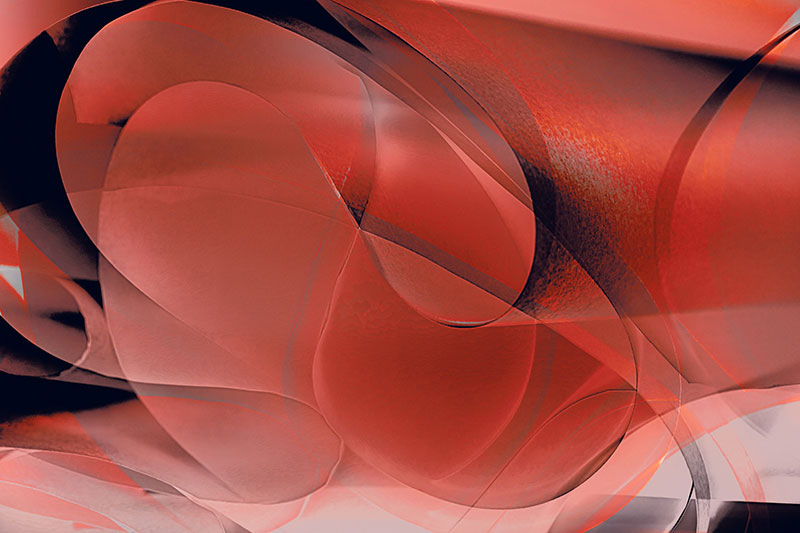
Susanna Patras, Castle of Dreams (from Kaleidoscope – paper abstracts), digital photograph, 27″ x 17″. Visit her page.
Exploring the Interplay Between Light and Shadows
“I am a visual artist who draws inspiration from the beauty of nature, as well as from the principles of modernism, minimalism, abstract expressionism, and the aesthetic of film noir.”
Susanna tells us she explores the interplay between light and shadows, “which can hide or reveal, inspired by the energy of the four elements, earth, water, wind and fire resulting sometimes in vivid colors, other times in subdued monochromatic tones.”
She adds, “A photograph can also resonate with a traditional Japanese ink painting, in which composition is not only about the careful placement of the subject in the frame, but also an experiment with the space between things. This is based on the concept of ‘Ma’, a Japanese word that means ‘space’ between two parts. I use my background in literature to create images that are striking and ethereal, ranging from bold, contrasty black and white compositions to soft, pastel-colored scenes.”
 Karen H. Salup, The White Path, mixed media, 40” x 40”. Visit her page.
Karen H. Salup, The White Path, mixed media, 40” x 40”. Visit her page.
Converting Memory to Process, Process to Painting…
Karen’s ebullient abstract expressionist paintings are guided by her intuitive process and created with a spontaneous and proficient use of color, design and composition. Karen explains, “My object is to convert memory to process, process to painting in a journey from nature to abstraction.”
Embodying the inherent qualities from the world of nature, music and other inspirational energetic sources Karen’s multi-layered paintings are comprised of emotive and lyrical gestural qualities.
She has stated, “My experience of studying the skies provides inspiration. By observing the lines and shapes of any subject, I try to create from an intuitive use of expressive color, drawing that transforms images into representations on canvas or paper supports. I enjoy creating forms dancing around the canvas. The application of building of layers with additional media reconstructs the work into abstraction.”
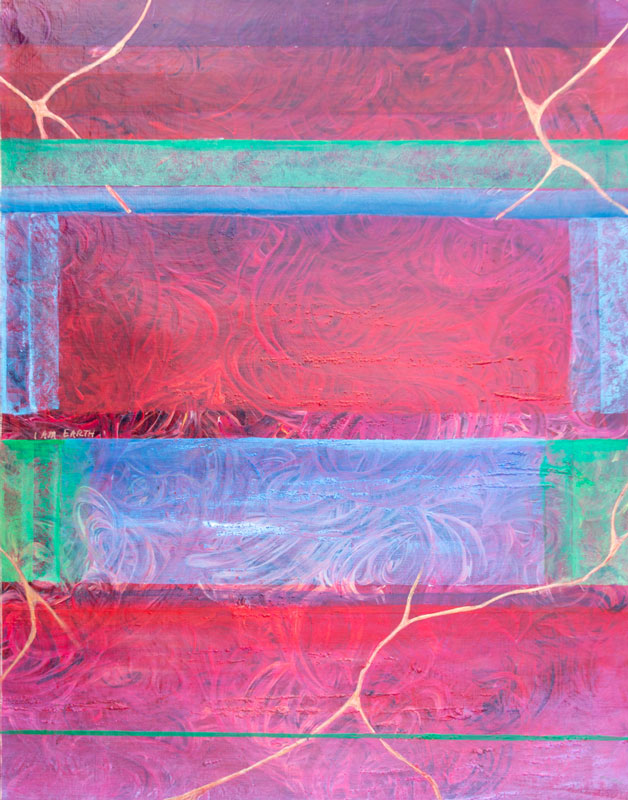 Rajul Shah, I am Earth, acrylic on linen, 21” x 28.5”. Visit her page.
Rajul Shah, I am Earth, acrylic on linen, 21” x 28.5”. Visit her page.
A Fusion of Philosophies…
Rajul Shah is internationally renowned for her ability to reinterpret spiritual spheres of knowledge and manifest them into innovative contemporary artistic expressions. Her healing art communicates peace and renewal and immediately arouses a transcendent experience for the viewer. Characterized by harmonious layers of color and intricate compositions, her art invites introspection.
Rajul states, “My work is a fusion of philosophies between the Japanese Art of Kintsugi and the spiritual teachings of the Chakras. Using the Aura from each chakra, I paint meditative abstracts of color.”
In her abstract paintings Rajul provides us with a profound realization of fragility and impermanence and much more. Imbued with spiritual insight she says it best: “Our scars do not define us; they become a canvas for rejuvenation, renewal, and an evolution into enhanced versions of ourselves, fortified with newfound strength and purpose.”
I particularly like Nancy Reyner’s work and how she describes her abstractions as “luminous notions of air, water, earth and light.” It’s good to convey to people that abstract art is different for each artist and viewer. Abstraction in art can vary so much, it’s a joy to explore the different methods and ideas.
Thank you for visiting and your comment about Nancy Reyner’s artwork. She is an extraordinary artist.
Great article Renee. I love reading about other abstract artists and their thoughts on this genre.
Nice article. Thanks Renee!
Love this article and reading the variety of interpretations of abstraction. Thank you!
Thank you for such informative and colourful information. I also, loved seeing Nancy Reyner’s work. I did two courses with Nancy, and was able to use lots of what I learned in those courses, to apply to what I read and saw here, it added an extra dimension of enjoyment. All in all the paintings, the writing and seeing Nancy’s painting, gave me a much needed boost, I have been inspired!. Trish Stewart
Hi Renee,
What a great idea to write about abstraction. I know its been done before but I like your concise and interesting angle to this article. Thank you for including me! As I began to read the article, seeing the Kandinsky made me pause. I remembered how many years ago Kandinsky’s books and paintings shifted my thinking towards abstraction. He was my idol for a long time. Maybe still is. His idea that color evokes sounds and a spiritual nature for the viewer was a big jumping off point for me to release “reality” in my work and move into something else. Thanks again for a great article!
Nancy
Thank you Nancy for sharing more information about being inspired by Kandinsky. Now, years later, you’re inspiring many artists!
Wonderful article Renee. Thanks so much for including my art.
Renee:
That was such an important era for abstract art. And Kandinsky bringing synaesthesia into the picture, although I’m sure there were many synaesthetes in prior centuries. Goes with the territory.
I love the current artists you add from around the world from Manhattan Arts International.
Tracy Ellyn